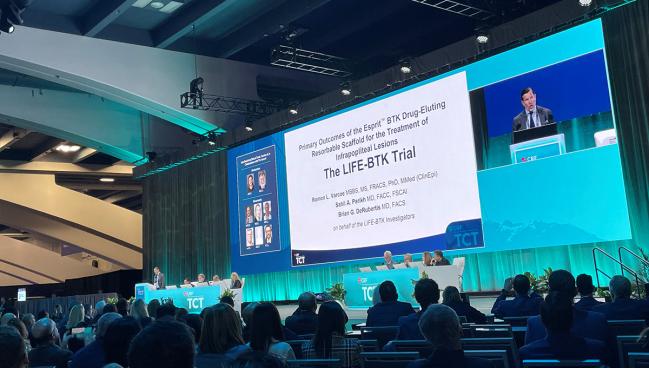LIFE-BTK: Bioresorbable Scaffold Holds Promise for Infrapopliteal CLTI
(UPDATED) Going beyond angioplasty to achieve long-term gains challenges current thinking in BTK treatment, says Eric Secemsky.

SAN FRANCISCO, CA—Esprit BTK (Abbott Vascular), an everolimus-eluting resorbable scaffold, is safe and effective in the treatment of infrapopliteal chronic limb-threatening ischemia (CLTI) compared with conventional angioplasty alone, 1-year results of the LIFE-BTK trial show.
Technologies for treating below-the-knee (BTK) infrapopliteal disease have been largely unsuccessful, LIFE-BTK senior study author Sahil Parikh, MD (NewYork-Presbyterian/Columbia University Irving Medical Center, New York, NY), told TCTMD, with operators frequently going with off-label use of coronary DES because they have nothing else.
“Hopefully we'll get a labeled indication if the FDA decides to approve this product, and then we'll have at least an option,” he said. “Also, the fact that we haven't seen other trials succeed [suggests that] maybe some of it is how we design these trials.”
BTK treatment options include BMS, DES, atherectomy/lithotripsy, drug-coated balloons, and angioplasty, but there are no dedicated devices for the infrapopliteal territory. While coronary DES have had some success as off-label therapy, they leave behind a stent that can become problematic if future interventions are needed. The recent BASIL-2 study supported the use of endovascular intervention over surgery in infrapopliteal CLTI, which is characterized by ischemic pain and nonhealing wounds. However, angioplasty has limitations, particularly in the “hostile” territory of the peripheral arteries, said Ramon Varcoe, MBBS, PhD (Prince of Wales Hospital, Sydney, Australia), in his presentation here at TCT 2023.
In the coronaries, the early promise of bioresorbable technology never bore fruit. The Absorb BVS (Abbott Vascular) was approved by the US Food and Drug Administration in 2016 on the basis of the ABSORB trials, after gaining CE Mark approval in Europe in 2011, but the later emergence of scaffold thrombosis in trials and meta-analyses led to the device being restricted in Europe. By 2017, it had been pulled from the market in the United States.
In the new study, patients who received the Esprit BTK scaffold had better outcomes in terms of freedom from amputation, occlusion, and reintervention than those treated with angioplasty alone.
Varcoe noted to TCTMD in a press conference that one of the great potentials of the scaffold device is that as it dissolves, it may allow the blood vessel to remodel and regain some of its vasomotor function. “That hasn't been proven yet in this study, but we're hopeful that that might be the case and longer-term follow-up might prove that to be true,” he added.
The study was simultaneously published in the New England Journal of Medicine.
Commenting for TCTMD, Eric Secemsky, MD (Beth Israel Deaconess Medical Center, Boston, MA), who was not involved in the trial, said he thinks the lessons learned from LIFE-BTK will help shape a new paradigm in treatment for BTK intervention with regard to achieving long-lasting patency.
“It’s a new concept, because what LIFE-BTK is saying is that just [conventional angioplasty] alone with a good result is not enough. Now we need to think about whether we can we get a better result if we plan to use a scaffold and look for longer term gains,” he said. “So, I think that is going to really challenge how we have been training and teaching and practicing for years.”
LIFE-BTK
The 261 patients (mean age 72.6 years; 32% female) enrolled in the multicenter trial had Rutherford class 4 or 5 CLTI and infrapopliteal artery stenosis or occlusion. Researchers randomly assigned them to receive the everolimus-eluting resorbable scaffold or percutaneous transluminal angioplasty, with up to two de novo or restenotic target lesions per patient eligible for treatment. All lesions were required to be located in separate arteries in the proximal two-thirds of the infrapopliteal space and have runoff to the ankle that was free of clinically significant disease. Overall, the study cohort had high rates of tobacco use, hypertension, hyperlipidemia, and prior PAD.
The investigational Esprit device consists of a bioresorbable poly-L lactide backbone with thin struts equivalent to contemporary coronary DES, and a coating of everolimus.
At baseline, treated lesions were a mean of 43.8 mm and 44.8 mm long in the scaffold and angioplasty groups, respectively. Procedural success was 91% and 70%, respectively. Bailout stenting was used in 6%. Those receiving the scaffold had 1 year of dual antiplatelet therapy (DAPT) while those in the angioplasty arm received 1 month of DAPT, with single antiplatelet therapy thereafter.
At a median follow-up of 390 days in the scaffold group and 397 days in the angioplasty group, the Kaplan-Meier estimate for the combined primary efficacy endpoint of freedom from amputation above the ankle of the target limb, occlusion of the target vessel, clinically driven revascularization of the target lesion, and binary restenosis of the target lesion was 74% in the scaffold group and 44% in the angioplasty group (one-sided P < 0.001 for superiority). The number-needed-to-treat (NNT) to avoid one adverse endpoint event was 4.
The original primary efficacy endpoint did not include freedom from binary restenosis of the target lesion, which was added after a prespecified interim analysis, according to the authors. Without that added into the endpoint, the Kaplan-Meier estimates were 83% versus 70% in the scaffold and angioplasty groups, respectively (P = 0.03).
A 1 year, binary restenosis had occurred in 46.5% of those in the angioplasty arm compared with 24.2% in the scaffold arm (P < 0.0001).
In landmark analyses of the primary efficacy endpoint, there was a steep drop in the angioplasty arm at 6 months, while the scaffold arm remained stable for the endpoint at 6 months and beyond.
The primary safety endpoint of freedom from major adverse limb events at 6 months and from perioperative death was met in 97% of patients who received the scaffold and all patients who received angioplasty (one-sided P < 0.001 for noninferiority). The number of serious adverse events related to the index procedure were similar at 2% in the scaffold group and 3% in the angioplasty group.
Varcoe said no subgroups were identified that would indicate that certain patient characteristics led to better response with the scaffold. “The infrapopliteal arteries just lend themselves better to the technology,” he added.
To TCTMD, Secemsky said the proximal tibia vessels generally have larger diameter, which should lead to better patency, explaining why the investigators would reserve use to the proximal two-thirds of tibial vessels with runoff, although those are a select set of CLTI patients.
“I think this will solve an important problem for a subset of lesions, but there is still a lot of disease that will be distal and that won't be addressable necessarily with the scaffold,” he added.
Potential for Synergism
Following the presentation, discussant David Kandzari, MD (Piedmont Heart Institute, Atlanta, GA), said the scaffold addresses many of the things lacking in current BTK treatment: providing “a safe and effective antiproliferative therapy that would mitigate against restenosis, offer scaffolding to prevent elastic recoil and reocclusion threatened by dissection, and ultimately fulfill these two promises without the requisite of a permanent implant.”
He also noted that LIFE-BTK included many patient groups that are often underrepresented in trials but widely seen in clinical practice, such as those with extensive disease burden and women, who account for nearly a third of the study population.
Building on VOYAGER-PAD’s success in preventing limb events by adding rivaroxaban to low-dose aspirin, panelist Dominick Angiolillo, MD, PhD (University of Florida College of Medicine – Jacksonville), asked Varcoe if there is an opportunity for synergism with the advent of the scaffold.
“I think there’s great potential there, as yet it’s untested,” Varcoe said, adding that the next steps for the scaffold research will include evaluating whether outcomes can be improved further with different anticoagulation and antiplatelet profiles.
L.A. McKeown is a Senior Medical Journalist for TCTMD, the Section Editor of CV Team Forum, and Senior Medical…
Read Full BioSources
Varcoe RL, DeRubertis BG, Kolluri R, et al. [Drug-eluting resorbable scaffold versus angioplasty for infrapopliteal artery disease.](https://www.nejm.org/doi/full/10.1056/NEJMoa2305637 N Engl J Med. 2023;Epub ahead of print.
Disclosures
- The study was funded by Abbott.
- Parikh reports serving on advisory boards for Abbott Vascular, Boston Scientific, Cordis, Medtronic, and Philips; receiving institutional research funding from Abbott Vascular, Boston Scientific, Surmodics, TriReme Medical, Shockwave Medical, Reflow Medical, Acotec, and Concept Medical; consulting for Terumo, Inari, Penumbra and Canon; and having equity in Advanced Nanotherapies, eFemoral, and Encompass Vascular.
- Varcoe reports consultant fee/honoraria/speaker's bureau for Boston Scientific Corporation, Philips, Nectero, Intervene, Surmodics, Abbott, Medtronic, W.L. Gore & Associates, R3 Vascular, Vesteck, Bard Medical, and Cook Medical, as well as having equity/stock(s)/options in Vesteck and EBR Systems.






Comments